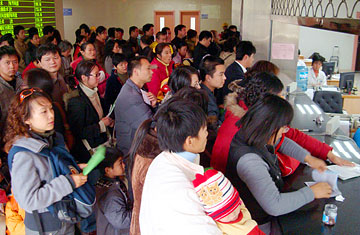
Local residents queue up to register or pay fees at a hospital in the Chinese city of Suzhou, in Jiangsu province, on Dec. 4, 2008
Every year when the wet winter weather sweeps through southern Anhui province, Ling Cheng gets a niggling cough that she just can't shake. But instead of heading to the medicine cabinet, Ling, like millions of other Chinese, heads instead to her local hospital for a dose of IV antibiotics. "When the coughing gets annoying, I just go to the clinic two or three days in a row and take a drip," she says. "After that it usually clears up straight away — it's much more effective than taking pills."
Last month, the country's Ministry of Health revealed that on average each Chinese person consumes 138 g of antibiotics per year — 10 times the amount consumed per capita in the U.S. Meanwhile, three times as many Chinese people are prescribed penicillin compared with the international standard. The Ministry also pointed out that 70% of inpatients at Chinese hospitals received antibiotics; the World Health Organization (WHO) recommends a maximum of 30%.
China's thirst for antibiotics has serious consequences. The WHO says the effectiveness of antibiotics is under threat from overuse in China, as diseases mutate to develop immunity. It estimates that 6.8% of tuberculosis cases in China are multidrug resistant, compared just 2% in developed countries. Experts believe that diseases as diverse as syphilis and the hospital superbug MRSA are thriving as they adapt to China's antibiotic-heavy environment. "We are now on the brink of losing this precious arsenal of medicines," Dr. Michael O'Leary, the WHO's China representative, said in a 2011 statement, calling for more responsible use of antibiotics. "The speed with which these drugs are being lost far outpaces the development of replacement drugs."
Despite the best efforts of health care officials, it is not clear just why the problem has grown so severe — or exactly what the solution might be. For many years, researchers believed the expectations of patients themselves were to blame: a patient didn't get an injection or a drip would feel that they weren't getting a good standard of care. But research by the WHO suggests that medical practitioners in China will often prescribe antibiotics "to be on the safe side," reasoning that at the very least the drugs won't harm their patients.
Financial motivations may also play a role. By some estimates the government subsidies cover just 8% of the running costs of hospitals, leaving the institutions to cover the other 92% by charging for care. At study called "Patient Knowledge and Antibiotic Abuse," published earlier this year by a team from China Europe International Business School, Princeton and Peking University, showed that drug sales now account for over 50% of all hospital revenues and antibiotics account for 47% of all drug sales — and that hospitals were allowed to charge a 15% markup on drug sales. They also found that doctors' incomes were also closely linked to their prescription of certain pharmaceuticals, with both bonuses from their hospitals and kickbacks from companies augmenting their salaries.
Across the country, local administrators are starting to take steps to tackle the problem. In Beijing, the municipal health bureau is currently undertaking a survey of antibiotics usage at 165 hospitals across the city. Those found to be overusing the drugs will have their rankings downgraded — a move that will directly affect the fees they can charge. Shanghai has rolled out a similar scheme that limits the variety of antibiotics each hospital can prescribe.
On the national level, a plan to curtail the use antibiotics through tighter regulation is also in the works. The Ministry of Health said last spring that it was drafting new laws, although the details have not been released. It is therefore unclear what effect, if any, the regulations will have, particularly because what seems to be similar measures have been in place for several years.
The team behind the antibiotic study argues that the simplest solution to the problem is patient education about the use and misuse of antibiotics. Their research showed that patients who displayed some knowledge of antibiotics were far less likely to be prescribed the drugs by their physician. "A simple intervention in which patient's display of knowledge about appropriate antibiotic use can dramatically reduce the abuse of antibiotics," the report said. However, it also noted that patients who broached the subject with their doctors faced "a deterioration in the quality of their interactions with the physician." And, really, who wants a grumpy doctor during flu season?
